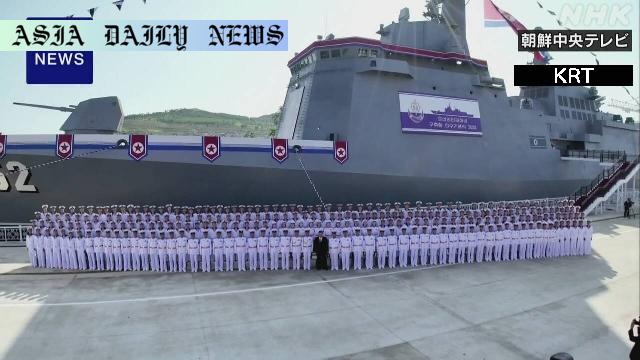Destroyer: North Korea holds launch ceremony for restored destroyer after critical May accident, aiming for strategic naval expansion.
- North Korea launched its restored 5,000-ton destroyer after an earlier accident.
- Kim Jong Un pledged to build two destroyers annually, showcasing naval ambitions.
- The vessel may represent strategic Pacific ambitions amid regional tensions.

Introduction: Rising Naval Tensions in Northeast Asia
North Korea has once again drawn global attention with the recent launch of its restored destroyer, underscoring its commitment to bolstering naval capabilities. The warship, identified as a “Choe Hyon-class” vessel weighing 5,000 tons, was presented ceremoniously at the Rajin Dockyard after substantial repairs following a tipping and partial submersion accident in May 2023. This event encapsulates the nation’s renewed military focus and competitive naval strategies amid broader geopolitical tensions in the Pacific theater.
The Choe Hyon-Class Destroyer: A Symbol of Power
Previously launched disastrously in May, the Choe Hyon-class destroyer holds symbolic significance for North Korea’s naval aspirations. As a 5,000-ton warship, the vessel not only represents technological advancements in domestic shipbuilding but also serves as a bold declaration of Pyongyang’s strategic intent. According to leader Kim Jong Un, the destroyer embodies North Korea’s readiness to defend sovereign waters against perceived adversarial threats. He emphasized the urgency of modernizing the navy by announcing plans to construct two larger or equivalent-class destroyers annually moving forward.
Kim Jong Un’s Vision: Strategic Intent in the Pacific
Kim Jong Un’s statements during the ceremony revealed an ambition to enhance naval strength significantly, potentially reshaping the balance of regional maritime power. His acknowledgment of ensuring “strategic abilities in the Pacific” mirrors a more aggressive stance. These remarks not only targeted rival countries but hinted at turning North Korea’s navy into an assertive force capable of impacting international waters near the Korean Peninsula. Pyongyang’s fixation on naval supremacy aligns with its broader strategy to counteract pressure from the United States, South Korea, and Japan.
Challenges and Skepticism
Despite the glowing accounts from North Korea’s state-run media, external observers remain skeptical of the new destroyer’s operational capabilities. The reported absence of external defects has been noted by South Korean experts, but the vessel’s performance post-repair remains unverified. Technical failures from the earlier mishap cast lingering doubts over Pyongyang’s shipbuilding expertise and quality assurance systems. Analysts are also raising questions about whether the nation can sustain such an ambitious construction pace without severe financial and resource constraints.
Regional Implications and Strategic Consequences
The launch of a repaired destroyer and Kim Jong Un’s pledge for future naval expansion raise concerns amongst neighboring countries. South Korea and Japan view the developments with trepidation, given the rising frequency of North Korean missile tests and nuclear proliferation. Meanwhile, the United States has amplified military cooperation with allies in the Indo-Pacific region. The augmenting of naval fleets adds yet another layer of complexity to an already volatile regional security landscape, increasing the likelihood of maritime confrontations or missteps in contested waters.
Conclusion: A Message to the World
The successful repair and relaunch of the Choe Hyon-class destroyer serve as a clear indication of North Korea’s resolve in asserting its military capabilities. While domestic propaganda paints this as an achievement signaling growing technological prowess, international scrutiny focuses on the broader implications for regional stability. As Pyongyang advances its naval strength, geopolitical pressures in Northeast Asia are likely to intensify, with potential ripple effects felt across the global stage.



Commentary
Introduction: The Significance of North Korea’s Naval Expansion
North Korea’s recent launch of the restored Choe Hyon-class destroyer is more than a military milestone. It represents a strategic pivot towards enhancing its maritime influence, posing critical questions for neighboring countries and global powers alike. Kim Jong Un’s public dedication to building two destroyers annually signals a bold, if not audacious, naval policy aimed at reshaping the balance of power in the region.
Symbolism Meets Reality: Parsing the Naval Message
The symbolism of successfully repairing a derailed naval project cannot be understated. It allows North Korea to project an image of resilience and determination in the face of setbacks. However, it remains to be seen whether the nation has the technological capacity and resource base to back its rhetoric. Pyongyang is no stranger to showcasing military prowess as a tool for regional intimidation, but the international community is likely to scrutinize whether this endeavor adds to its operational military capacity or merely serves propagandistic purposes.
Implications for Neighboring Countries
South Korea, Japan, and other Indo-Pacific nations are sure to interpret this development as a call for recalibrating their defensive postures. Regional naval maneuvers and military developments could potentially escalate as nations react to North Korea’s new ambitions. These events place further strain on already fragile diplomatic relations and could ignite unforeseen conflicts in contested waters.
Personal Reflection and Broader Considerations
Reflecting on North Korea’s actions, one cannot help but consider the broader objectives driving its leadership. Is this genuine self-preservation or a calculated challenge to the status quo in the Pacific? Regardless of the motivation, the launch serves as a potent reminder of how military displays can amplify regional instability. Whether this leads to more productive diplomacy or heightened confrontation will depend heavily on the international community’s response.